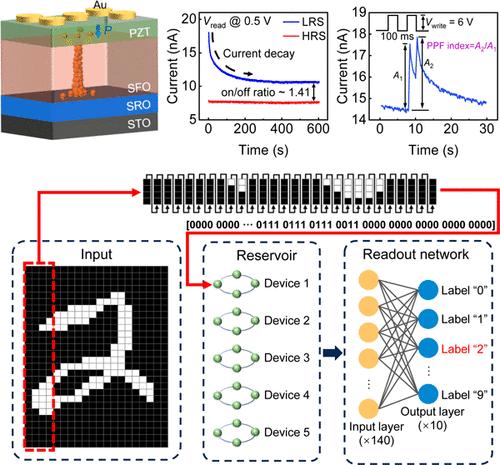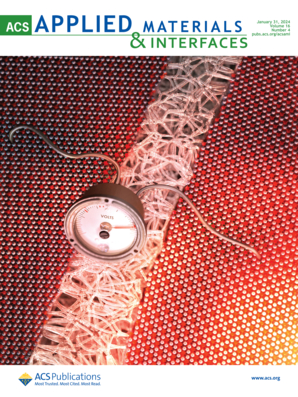Volatile Resistive Switching and Short-Term Synaptic Plasticity in a Ferroelectric-Modulated SrFeOx Memristor
IF 8.2
2区 材料科学
Q1 MATERIALS SCIENCE, MULTIDISCIPLINARY
引用次数: 0
Abstract
SrFeOx (SFO) offers a topotactic phase transformation between an insulating brownmillerite SrFeO2.5 (BM-SFO) phase and a conductive perovskite SrFeO3 (PV-SFO) phase, making it a competitive candidate for use in resistive memory and neuromorphic computing. However, most of existing SFO-based memristors are nonvolatile devices which struggle to achieve short-term synaptic plasticity (STP). To address this issue and realize STP, we propose to leverage ferroelectric polarization to effectively draw ions across the interface so that the PV-SFO conductive filaments (CFs) can be ruptured in absence of an external field. As a proof of concept, we fabricate ferroelectric Pb(Zr0.2Ti0.8)O3 (PZT)/BM-SFO bilayer films with Au top electrodes and SrRuO3 bottom electrodes. The device exhibits the desired volatile resistive switching behavior, with its low resistance state decaying over time. Such volatility is attributed to the positive polarization charge near the PZT/SFO interface, which can attract the oxygen ions from SFO to PZT and hence lead to the rupture of CFs. Moreover, this volatile device successfully emulates STP-related synaptic functions, including excitatory postsynaptic current, paired-pulse facilitation, learning-experience behavior, associative learning, and reservoir computing. Our study showcases an effective method for achieving volatile resistive switching and STP, which may be applied to various systems beyond SFO-based memristors.

铁电调制SrFeOx记忆电阻器的挥发性电阻开关和短期突触可塑性
SrFeOx (SFO)在绝缘棕镍矿SrFeO2.5 (BM-SFO)相和导电钙钛矿SrFeO3 (PV-SFO)相之间提供拓扑定向相变,使其成为电阻性记忆和神经形态计算领域的竞争候选材料。然而,现有的基于sfo的忆阻器大多是非易失性器件,难以实现短期突触可塑性(STP)。为了解决这一问题并实现STP,我们提出利用铁电极化来有效地吸引离子穿过界面,从而使PV-SFO导电丝(CFs)在没有外场的情况下断裂。作为概念验证,我们制作了铁电Pb(Zr0.2Ti0.8)O3 (PZT)/BM-SFO双层膜,其上电极为Au,下电极为SrRuO3。该器件表现出所需的挥发性电阻开关行为,其低电阻状态随时间衰减。这种挥发性是由于PZT/SFO界面附近的正极化电荷,它可以将SFO中的氧离子吸引到PZT中,从而导致CFs的破裂。此外,该挥发性装置成功地模拟了stp相关的突触功能,包括兴奋性突触后电流、配对脉冲促进、学习经验行为、联想学习和储层计算。我们的研究展示了一种实现挥发性电阻开关和STP的有效方法,它可以应用于基于sfo的记忆电阻器以外的各种系统。
本文章由计算机程序翻译,如有差异,请以英文原文为准。
求助全文
约1分钟内获得全文
求助全文
来源期刊

ACS Applied Materials & Interfaces
工程技术-材料科学:综合
CiteScore
16.00
自引率
6.30%
发文量
4978
审稿时长
1.8 months
期刊介绍:
ACS Applied Materials & Interfaces is a leading interdisciplinary journal that brings together chemists, engineers, physicists, and biologists to explore the development and utilization of newly-discovered materials and interfacial processes for specific applications. Our journal has experienced remarkable growth since its establishment in 2009, both in terms of the number of articles published and the impact of the research showcased. We are proud to foster a truly global community, with the majority of published articles originating from outside the United States, reflecting the rapid growth of applied research worldwide.
 求助内容:
求助内容: 应助结果提醒方式:
应助结果提醒方式:


